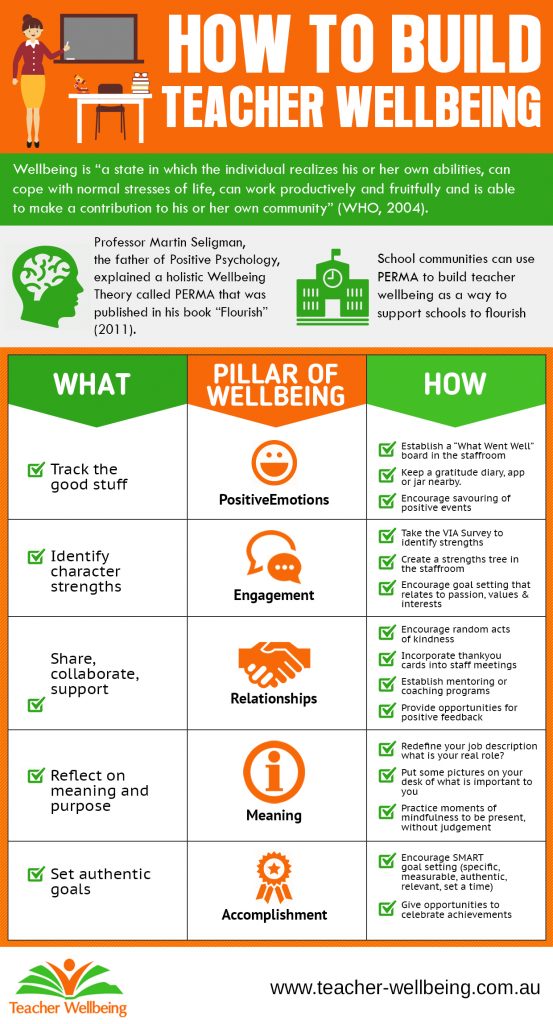Using PERMA pillars to support teachers

With over 20 years of experience as a teacher, you don’t have to tell me that teachers are among those professionals with the highest levels of job stress and burnout across many countries (Stoeber & Rennert, 2008).

What we also know from the research is that ‘well teachers’ equal ‘well students’ (Roffey, 2012). Yet, as the demands on teachers increase; having to be involved in about 1000 interpersonal contacts every day (Holmes 2005), the quality of these contacts can either jeopardise or enhance a person’s wellbeing. In a nutshell, teachers can humiliate or humour, hurt or heal, humanise or de-humanise students in their classrooms. Not because they don’t care, but because they feel overwhelmed due to the pressure and expectations that both themselves and society place on the role.
The bottom-line is that our teachers need more support and better strategies to manage the cognitive and emotional demands of the job. If teachers have evidence-based strategies to better understand and support their own wellbeing, they will be better placed to not only survive but flourish and become better role models for our students. If we truly want to help young people flourish, we must begin with our teachers.
Thankfully, science is paving the way with proven strategies and tools to enhance wellbeing both individually and across organisations from the field of positive psychology. Wellbeing is a multidimensional construct that typically differentiates between hedonic wellbeing (feeling good) and eudaimonic well-being (functioning well). Positive psychology aims to merge these two forms of thought through the study of optimal human functioning and what makes life most worth living.
Martin Seligman, often considered the father of positive psychology wanted to bridge the hedonic/eudaimonic divide by identifying wellbeing as a construct that was not limited to life satisfaction alone but as several contributing factors, which formed the mnemonic PERMA.
Positive emotion, Engagement, Relationships, Meaning and Accomplishment.
The model is often described as ‘pillars’ and involves assisting individuals to explore the five domains that encompass PERMA as a way of holding themselves up. While the model has not been designed to be prescriptive, the evidence within each pillar tells us there are simple things we can do support our own wellbeing.
Perhaps you could consider these five questions:
- Positive emotion. When are you happiest at work? What emotion are you experiencing?
- Engagement. What do you love most about your current role? What strength are you using?
- Relationships. Who supports you most at work? Who do you support?
- Meaning. What is most important to you about your role? Why do you do what you do?
- Accomplishment. What big or small achievements have you made in the past week-month?
Of course, answering these questions is not going to help you tick off things on your to-do list, nor is it going to solve systemic flaws that cause excessive admin. But what if, by reflecting on these questions every so often, you are able to shift your focus to what is working instead of what isn’t working.
Perhaps that could be the moment you have a meaningful connection of conversation with a student and they remember it for the rest of their life. Perhaps these small shifts in mindset lead to more productive conversations in the staff room. Perhaps reflecting on how we support our wellbeing is the first step to shifting habits and moving towards a positive organisational culture.
If you want to learn more, you must read the foundational book by Martin Seligman, Flourish. You can find more specific tools that map PERMA to both classroom and staff room strategies online.







